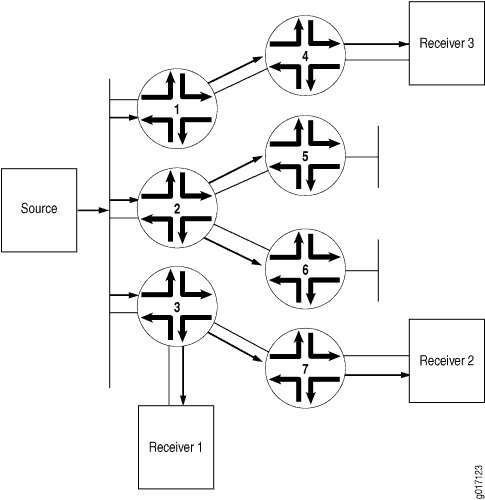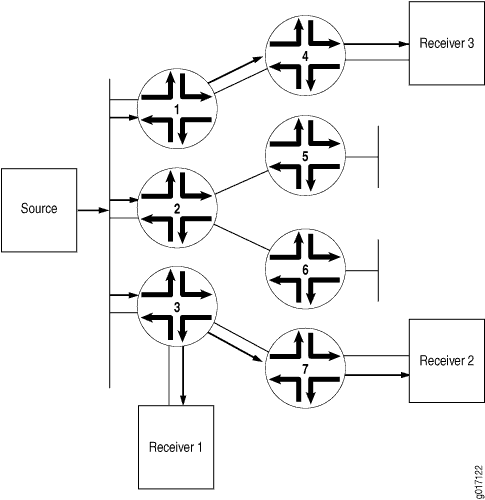Sparse-dense mode, as the name implies, allows the interface to operate on a per-group basis in either sparse or dense mode. A group specified as dense is not mapped to an RP. Instead, data packets destined for that group are forwarded by means of PIM dense-mode rules. A group specified as sparse is mapped to an RP, and data packets are forwarded by means of PIM sparse-mode rules.
Understanding PIM Sparse Mode
A Protocol Independent Multicast (PIM) sparse-mode domain uses reverse-path forwarding (RPF) to create a path from a data source to the receiver requesting the data. When a receiver issues an explicit join request, an RPF check is triggered. A (*,G) PIM join message is sent toward the RP from the receiver’s designated router (DR). (By definition, this message is actually called a join/prune message, but for clarity in this description, it is called either join or prune, depending on its context.) The join message is multicast hop by hop upstream to the ALL-PIM-ROUTERS group (224.0.0.13) by means of each router’s RPF interface until it reaches the RP. The RP router receives the (*,G) PIM join message and adds the interface on which it was received to the outgoing interface list (OIL) of the rendezvous-point tree (RPT) forwarding state entry. This builds the RPT connecting the receiver with the RP. The RPT remains in effect, even if no active sources generate traffic.NOTE
State—the (*,G) or (S,G) entries—is the information used for forwarding unicast or multicast packets. S is the source IP address, G is the multicast group address, and * represents any source sending to group G. Routers keep track of the multicast forwarding state for the incoming and outgoing interfaces for each group.
When a source becomes active, the source DR encapsulates multicast data packets into a PIM register message and sends them by means of unicast to the RP router.
If the RP router has interested receivers in the PIM sparse-mode domain, it sends a PIM join message toward the source to build a shortest-path tree (SPT) back to the source. The source sends multicast packets out on the LAN, and the source DR encapsulates the packets in a PIM register message and forwards the message toward the RP router by means of unicast. The RP router receives PIM register messages back from the source, and thus adds a new source to the distribution tree, keeping track of sources in a PIM table. Once an RP router receives packets natively (with S,G), it sends a register stop message to stop receiving the register messages by means of unicast.
In actual application, many receivers with multiple SPTs are involved in a multicast traffic flow. To illustrate the process, we track the multicast traffic from the RP router to one receiver. In such a case, the RP router begins sending multicast packets down the RPT toward the receiver’s DR for delivery to the interested receivers. When the receiver’s DR receives the first packet from the RPT, the DR sends a PIM join message toward the source DR to start building an SPT back to the source. When the source DR receives the PIM join message from the receiver’s DR, it starts sending traffic down all SPTs. When the first multicast packet is received by the receiver’s DR, the receiver’s DR sends a PIM prune message to the RP router to stop duplicate packets from being sent through the RPT. In turn, the RP router stops sending multicast packets to the receiver’s DR, and sends a PIM prune message for this source over the RPT toward the source DR to halt multicast packet delivery to the RP router from that particular source.
If the RP router receives a PIM register message from an active source but has no interested receivers in the PIM sparse-mode domain, it still adds the active source into the PIM table. However, after adding the active source into the PIM table, the RP router sends a register stop message. The RP router discovers the active source’s existence and no longer needs to receive advertisement of the source (which utilizes resources).NOTE
If the number of PIM join messages exceeds the configured MTU, the messages are fragmented in IPv6 PIM sparse mode. To avoid the fragmentation of PIM join messages, the multicast traffic receives the interface MTU instead of the path MTU.
The major characteristics of PIM sparse mode are as follows:
- Routers with downstream receivers join a PIM sparse-mode tree through an explicit join message.
- PIM sparse-mode RPs are the routers where receivers meet sources.
- Senders announce their existence to one or more RPs, and receivers query RPs to find multicast sessions.
- Once receivers get content from sources through the RP, the last-hop router (the router closest to the receiver) can optionally remove the RP from the shared distribution tree (*,G) if the new source-based tree (S,G) is shorter. Receivers can then get content directly from the source.The transitional aspect of PIM sparse mode from shared to source-based tree is one of the major features of PIM, because it prevents overloading the RP or surrounding core links.
There are related issues regarding source, RPs, and receivers when sparse mode multicast is used:
- Sources must be able to send to all RPs.
- RPs must all know one another.
- Receivers must send explicit join messages to a known RP.
- Receivers initially need to know only one RP (they later learn about others).
- Receivers can explicitly prune themselves from a tree.
- Receivers that never transition to a source-based tree are effectively running Core Based Trees (CBT).
PIM sparse mode has standard features for all of these issues.
Rendezvous Point
The RP router serves as the information exchange point for the other routers. All routers in a PIM domain must provide mapping to an RP router. It is the only router that needs to know the active sources for a domain—the other routers just need to know how to reach the RP. In this way, the RP matches receivers with sources.
The RP router is downstream from the source and forms one end of the shortest-path tree. As shown in Figure 1, the RP router is upstream from the receiver and thus forms one end of the rendezvous-point tree.

The benefit of using the RP as the information exchange point is that it reduces the amount of state in non-RP routers. No network flooding is required to provide non-RP routers information about active sources.
RP Mapping Options
RPs can be learned by one of the following mechanisms:
- Static configuration
- Anycast RP
- Auto-RP
- Bootstrap router
We recommend a static RP mapping with anycast RP and a bootstrap router (BSR) with auto-RP configuration because static mapping provides all the benefits of a bootstrap router and auto-RP without the complexity of the full BSR and auto-RP mechanisms.
Understanding PIM Dense Mode
PIM dense mode is less sophisticated than PIM sparse mode. PIM dense mode is useful for multicast LAN applications, the main environment for all dense mode protocols.
PIM dense mode implements the same flood-and-prune mechanism that DVMRP and other dense mode routing protocols employ. The main difference between DVMRP and PIM dense mode is that PIM dense mode introduces the concept of protocol independence. PIM dense mode can use the routing table populated by any underlying unicast routing protocol to perform reverse-path-forwarding (RPF) checks.
Internet service providers (ISPs) typically appreciate the ability to use any underlying unicast routing protocol with PIM dense mode because they do not need to introduce and manage a separate routing protocol just for RPF checks. While unicast routing protocols extended as multiprotocol BGP (MBGP) and Multitopology Routing in IS-IS (M-IS-IS) were later employed to build special tables to perform RPF checks, PIM dense mode does not require them.
PIM dense mode can use the unicast routing table populated by OSPF, IS-IS, BGP, and so on, or PIM dense mode can be configured to use a special multicast RPF table populated by MBGP or M-IS-IS when performing RPF checks.
Unlike sparse mode, in which data is forwarded only to routing devices sending an explicit request, dense mode implements a flood-and-prune mechanism, similar to DVMRP. In PIM dense mode, there is no RP. A routing device receives the multicast data on the interface closest to the source, then forwards the traffic to all other interfaces.

Flooding occurs periodically. It is used to refresh state information, such as the source IP address and multicast group pair. If the routing device has no interested receivers for the data, and the OIL becomes empty, the routing device sends a prune message upstream to stop delivery of multicast traffic
